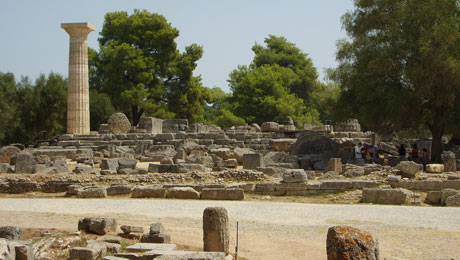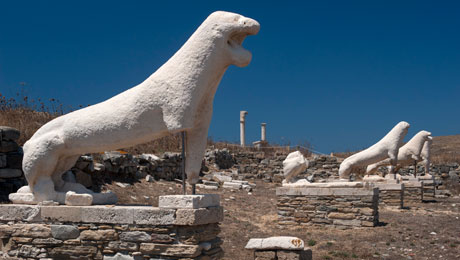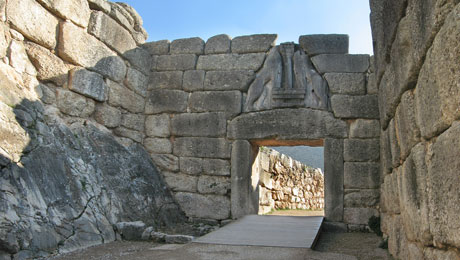The medieval city of Rhodes developed around the castle without a specific town plan and probably after an earthquake in 515. According to the description on UNESCO’s website, the Knights Hospitaller of the Order of St. John of Jerusalem bought the island and controlled it from 1309 to 1523. Then, the Ottoman Empire and later, the Venetians conquered Rhodes. It is considered one of the oldest medieval towns and a vibrant meeting place of different cultures.
1989: Mystras
Mystras was a Byzantine city. Only ruins have survived to this today despite the restoration of some buildings. Its history begins in the 13th century, when the Franks conquered the Peloponnese.
In 1249, William II de Villehardouin built a fortress on a cone-shaped hill called Mystras or Mizitras in the eastern part of Mount Taygetus.

1989: Olympia
Olympia was the place where the Olympic Games were held in ancient times. There was the statue of Zeus, made of gold and ivory, considered one of the Seven Wonders of the World at that time.
Although the site was discovered in 1766, the excavations began only in 1829 by French archaeologists.
The first major operation to reveal the secrets of Olympia began in 1875 and was financed by Germany. The archaeologists found then the statues of the goddess Nike of Samothrace and of Hermes by sculptor Praxiteles as well as 14,000 objects in total.

1990: Delos
In Ancient Greece, the Island of Delos was considered sacred because according to mythology, there Leto gave birth to twins Artemis and Apollo. According to mythology again, Delos was a floating island once, wandering across seas, until Zeus ordered Poseidon to stop its floating in order for the pregnant Leto to be able to hide and give birth there. For a long time, the small town of Delos survived on the revenue from the temple of Apollo, which had a religious significance. Its religious role was so great that after 426 BC, people were forbidden to give birth and die there. Later, it became a major centre of international trade and was particularly known as the largest slave market in the Mediterranean. The island is used as an open-air museum and is "closed" on Monday. So far, archaeologists have been able to find the remains of three temples of Apollo, a temple of Artemis, a temple of the god Triton, a temple of Hera, the Terrace of the Lions and other sanctuaries.
1990: Monasteries of Daphni, Hosios Loukas and Nea Moni of Chios
The Monastery of Daphni was founded in the 6th century on the ruins of the Temple of Apollo Daphnaios, which had been destroyed by the Goths in 395. Only one of the Ionic columns of the ancient temple has survived until today. The others were sent to London by Lord Elgin.
The Hosios Loukas monastery was built on the western slopes of Mount Helicon in the area of Viotia. It is one of the most important monuments of medieval art and architecture.
Nea Moni of Chios is an old historic monastery founded in 1042 AD, world-renowned for its exceptional artistic mosaics.
1992: Pythagoreio and Heraion of Samos
The remains of the eponymous ancient temple dedicated to the goddess Hera are at Heraion in the southern part of the island. Typical of the temple is the appearance of only one upright column.
Pythagoreio is a village in the south-eastern part of the island, named after the great Greek philosopher and mathematician Pythagoras, who was born on the island.
1996: Vergina
The city of Vergina became world famous in 1977 when the Greek archaeologist Manolis Andronikos found a tomb, which he considered to have belonged to the father of Alexander of Macedonia, Philip II.

1999: Mycenae and Tiryns
Mycenae and Tiryns were the two largest cities of the Mycenaean kingdom and Homer praised them in his epic poems the Iliad and the Odyssey. Mycenae was one of the most important centres in antiquity and the Mycenaean kingdom actually was the first Greek civilization that replaced the Minoan Crete that had military dominance over much of southern Greece around 400. Dominant in the eastern Mediterranean, the Mycenaean civilization laid the foundations of classical Greek culture and set the course of its development. Archaeologist Heinrich Schliemann discovered Mycenae in 1866.
1999: Chora, Monastery of St. John the Theologian and the Cave of the Apocalypse in Patmos
The monastery was founded in 1088 AD and built near the Cave of the Apocalypse. Both the Orthodox and the Catholic Church assume that Apostle John wrote his Gospel and Revelation there.

2007: Old Town of Corfu
The Old Town of Corfu with the old and the new castle and traces of many influences is situated at the entrance of the Adriatic Sea and it has been continuously inhabited since ancient times.
Due to its strategic location, it became an important port, which protected the island from multiple sieges. The Old Town of Corfu is considered one of the most important fortified cities in the Mediterranean.